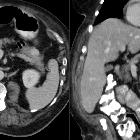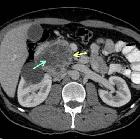pancreatic neoplasms

Extra-gastrointestinal
stromal tumor of the pancreas: case report and review of the literature. Abdominal CT scan showing a 2-cm, contrast-enhanced mass (arrow) in the uncinate process of the pancreas.
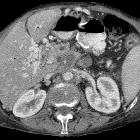
Pfortaderverschluss
mit kavernöser Transformation bei Pankreaskarzinom. Computertomographie.

Pancreatic
ductal adenocarcinoma • Pancreatic carcinoma - Ganzer Fall bei Radiopaedia
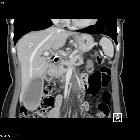
Pancreatic
ductal adenocarcinoma • Pancreatic cancer - invasive ductal adenocarcinoma - Ganzer Fall bei Radiopaedia
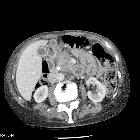
Pancreatic
ductal adenocarcinoma • Pancreatic cancer (T4) - uncinate process - Ganzer Fall bei Radiopaedia
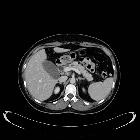
Pancreatic
ductal adenocarcinoma • Pancreatic cancer - uncinate process - Ganzer Fall bei Radiopaedia
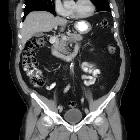
Pancreatic
ductal adenocarcinoma • Pancreatic carcinoma with portal vein invasion - Ganzer Fall bei Radiopaedia

Pancreatic
ductal adenocarcinoma • Pancreatic head adenocarcinoma with choledocoduodenal fistula - Ganzer Fall bei Radiopaedia
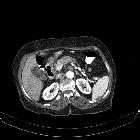
Pancreatic
ductal adenocarcinoma • Pancreatic ductal adenocarcinoma - Ganzer Fall bei Radiopaedia

Pancreatic
ductal adenocarcinoma • Double duct sign - Ganzer Fall bei Radiopaedia

Pancreatic
ductal adenocarcinoma • Pancreatic adenocarcinoma (T4) - Ganzer Fall bei Radiopaedia

Pancreatic
ductal adenocarcinoma • Pancreatic head adenocarcinoma - Ganzer Fall bei Radiopaedia

Pancreatic
ductal adenocarcinoma • Pancreatic carcinoma - Ganzer Fall bei Radiopaedia

Pancreatic
ductal adenocarcinoma • Pancreatic adenocarcinoma - Ganzer Fall bei Radiopaedia

Pancreatic
ductal adenocarcinoma • Pancreatic ductal adenocarcinoma - Ganzer Fall bei Radiopaedia

Pancreatic
ductal adenocarcinoma • Pancreatic adenocarcinoma - Ganzer Fall bei Radiopaedia

Pancreatic
ductal adenocarcinoma • Pancreatic ductal adenocarcinoma - Ganzer Fall bei Radiopaedia

Secretin-stimulated
MR cholangiopancreatography: spectrum of findings in pancreatic diseases. a–g Ductal adenocarcinoma. Axial T2-weighted (a, b) and axial post-contrast T1-weighted images (c, d) show a small lesion at the level of the pancreatic body with an abrupt cut-off of the main pancreatic duct, better visualised on MRCP (e). After secretin stimulation (f, g) there is a persistent stenosis, without the duct-penetrating sign

Pancreatic
ductal adenocarcinoma • Metastatic adenocarcinoma of the pancreas tail with colon obstruction - Ganzer Fall bei Radiopaedia

Pancreatic
ductal adenocarcinoma • Pancreatic adenocarcinoma - uncinate process - Ganzer Fall bei Radiopaedia

Pancreatic
ductal adenocarcinoma • Pancreas adenocarcinoma - uncinate process - Ganzer Fall bei Radiopaedia

Pancreatic
ductal adenocarcinoma • Pancreas ductal adenocarcinoma - unresectable - Ganzer Fall bei Radiopaedia

Pancreatic
ductal adenocarcinoma • Pancreatic adenocarcinoma - borderline ressectable - Ganzer Fall bei Radiopaedia

Pancreatic
ductal adenocarcinoma • Pancreatic adenocarcinoma - Ganzer Fall bei Radiopaedia

Pancreatic
ductal adenocarcinoma • Metastatic pancreatic ductal adenocarcinoma - Ganzer Fall bei Radiopaedia

Pancreatic
neoplasms • Insulinoma - Ganzer Fall bei Radiopaedia

Pancreatic
neoplasms • Insulinoma - MEN type 1 - Ganzer Fall bei Radiopaedia

Pancreatic
neoplasms • Islet-cell tumor of the pancreas - Ganzer Fall bei Radiopaedia

Pancreatic
neoplasms • Pancreatic adenocarcinoma - Ganzer Fall bei Radiopaedia
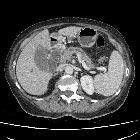
Pancreatic
neoplasms • ERCP for pancreatic cancer complicated by perforation of pharyngeal pouch - Ganzer Fall bei Radiopaedia

Pancreatic
neoplasms • Pancreatic neuroendocrine tumor and serous cystadenoma - Ganzer Fall bei Radiopaedia

Pancreatic
neoplasms • Metastatic pancreatic adenocarcinoma - Ganzer Fall bei Radiopaedia

Pancreatic
ductal adenocarcinoma • Pancreatic carcinoma (gross pathology) - Ganzer Fall bei Radiopaedia

Azinuszellkarzinom
des Pankreasschwanz in der Computertomographie axial: Große, zentral hypodens regressiv veränderte Raumforderung mit relativ glattem Rand. Etwas freie Flüssigkeit. Etwas flaue Kontrastierung, eigentlich p.v.

Pancreatic
cancer in computertomography. The patient suffered from back-pain and was treated successfully by Celiac Plexus Blockade.

Pancreatic
ductal adenocarcinoma • Pancreatic cancer - Ganzer Fall bei Radiopaedia

Pancreatic
ductal adenocarcinoma • Pancreatic adenocarcinoma - Ganzer Fall bei Radiopaedia
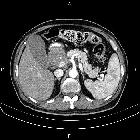
Pancreatic
ductal adenocarcinoma • Pancreatic adenocarcinoma - Ganzer Fall bei Radiopaedia

Pancreatic
ductal adenocarcinoma • Pancreatic adenocarcinoma on top of chronic pancreatitis - Ganzer Fall bei Radiopaedia

Pancreatic
ductal adenocarcinoma • Pancreatic cancer - Ganzer Fall bei Radiopaedia

Pancreatic
ductal adenocarcinoma • Pancreatic adenocarcinoma - Ganzer Fall bei Radiopaedia

Pancreatic
ductal adenocarcinoma • Metastatic pancreatic cancer - Ganzer Fall bei Radiopaedia

Pancreatic
ductal adenocarcinoma • Metastatic pancreatic cancer - Ganzer Fall bei Radiopaedia
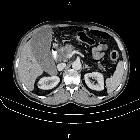
Pancreatic
ductal adenocarcinoma • Pancreatic cancer - Ganzer Fall bei Radiopaedia
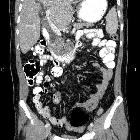
Pancreatic
ductal adenocarcinoma • Metastatic pancreatic cancer - Ganzer Fall bei Radiopaedia

Pancreatic
ductal adenocarcinoma • Pancreatic cancer - Ganzer Fall bei Radiopaedia

Pancreatic
ductal adenocarcinoma • Pancreatic cancer - Ganzer Fall bei Radiopaedia
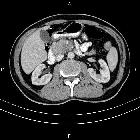
Pancreatic
ductal adenocarcinoma • Pancreatic adenocarcinoma - Ganzer Fall bei Radiopaedia

Pancreatic
ductal adenocarcinoma • Pancreatic adenocarcinoma (ultrasound) - Ganzer Fall bei Radiopaedia

Pancreatic
ductal adenocarcinoma • Metastatic pancreatic adenocarcinoma - Ganzer Fall bei Radiopaedia

Pancreatic
ductal adenocarcinoma • Pancreatic cancer - Ganzer Fall bei Radiopaedia

Pancreatic
ductal adenocarcinoma • Metastatic pancreatic cancer - Ganzer Fall bei Radiopaedia

Pancreatic
ductal adenocarcinoma • Pancreatic cancer - Ganzer Fall bei Radiopaedia

Pancreatic
ductal adenocarcinoma • Metastatic pancreatic adenocarcinoma - Ganzer Fall bei Radiopaedia

Pancreatic
ductal adenocarcinoma • Locally advanced metastatic pancreatic cancer - Ganzer Fall bei Radiopaedia

Pancreatic
ductal adenocarcinoma • Pancreatic ductal adenocarcinoma - Ganzer Fall bei Radiopaedia

Pancreatic
ductal adenocarcinoma • Pancreatic adenocarcinoma - Ganzer Fall bei Radiopaedia

Pancreatic
ductal adenocarcinoma • Pancreatic adenocarcinoma - Ganzer Fall bei Radiopaedia
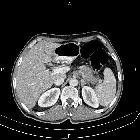
Pancreatic
ductal adenocarcinoma • Pancreatic adenocarcinoma - Ganzer Fall bei Radiopaedia

Pancreatic
ductal adenocarcinoma • Metastatic pancreatic cancer - Ganzer Fall bei Radiopaedia

Pancreatic
ductal adenocarcinoma • Metastatic pancreatic ductal adenocarcinoma - Ganzer Fall bei Radiopaedia

Pancreatic
ductal adenocarcinoma • Double duct sign - Ganzer Fall bei Radiopaedia

Pancreatic
ductal adenocarcinoma • Pancreatic adenocarcinoma - Ganzer Fall bei Radiopaedia

Pancreatic
ductal adenocarcinoma • Pancreatic adenocarcinoma - Ganzer Fall bei Radiopaedia

Pancreatic
ductal adenocarcinoma • Pancreatic adenocarcinoma - Ganzer Fall bei Radiopaedia

Pfortaderverschluss
mit kavernöser Transformation bei Pankreaskarzinom. Hier zusätzlich dargestellte Thrombose der Vena cava inferior. Computertomographie.

Pfortaderverschluss
mit kavernöser Transformation bei Pankreaskarzinom. Computertomographie.
There are numerous primary pancreatic neoplasms, in part due to the mixed endocrine and exocrine components.
Classification
Classification based on function
- exocrine: ~99% of all primary pancreatic neoplasms
- pancreatic ductal adenocarcinoma ~90-95%
- cystic neoplasm
- intraductal papillary mucinous neoplasm (IPMN)
- endocrine: were previously referred to as islet cell tumors because they were thought to have originated from the islets of Langerhans, however, new evidence suggests that these tumors originate from pluripotential stem cells in ductal epithelium
- non-syndromic
- syndromic
- mesenchymal tumors
- although the great majority of both benign and malignant pancreatic neoplasms arise from pancreatic epithelial cells, mesenchymal tumors, while rare, can derive from the connective, lymphatic, vascular, and neuronal tissues of the pancreas
- they account for 1-2% of all pancreatic tumors and are classified according to their histologic origin
- other
Exocrine tumors
- ductal adenocarcinoma is by far the most common primary tumor, usually of the head (65%) and has a very poor prognosis.
- cystic neoplasms are further divided into (with some overlap):
- unilocular
- intraductal papillary mucinous neoplasms (IPMN)
- serous cystadenoma uncommonly uni/macrolocular
- macrocystic multilocular
- mucinous cystic neoplasm: usually body and tail
- intraductal papillary mucinous neoplasms (IPMN)
- serous cystadenoma uncommonly uni/macrolocular
- microcystic
- serous cystadenoma: usually head. 30% have a central scar
- cystic with a solid component
- macrocystic tumors can have solid component as well
- pancreatic adenocarcinoma may undergo cystic degeneration (8%)
- unilocular
- generally solid
See also: cystic pancreatic mass: differential diagnosis
Endocrine tumors
Endocrine tumors of the pancreas are divided into:
- functional: ~85%
- insulinoma: most common, 10% are malignant
- gastrinoma: second most common, 60% malignant
- glucagonoma: 80% malignant
- VIPoma: 75% malignant
- somatostatinoma: 75% malignant
- non-functional: ~15%
- third most common
- 85-100% malignant
- usually larger, as a result of lack of hormonal activity, the clinical presentations are usually delayed till they become large
Mesenchymal tumors
Account for 1-2% of all pancreatic tumors and are classified according to their histologic origin :
These are further discussed at pancreatic mesenchymal neoplasms
Classification based on location
Head
- ductal adenocarcinoma
- intraductal papillary mucinous neoplasms (IPMN)
- serous cystadenoma
- pancreatoblastoma (rare and in children)
Body and tail
Intraductal
- intraductal papillary mucinous neoplasm (IPMN)
- pancreatic intraductal neoplasia (PanIN)
- intraductal tubular neoplasm (ITN)
- intraductal tubulopapillary neoplasm (ITPN)
- intraductal tubular adenoma (ITA)
- intraductal tubular carcinoma (ITC)
Siehe auch:
- Pankreaskarzinom
- Zöliakusblockade
- zystische Pankreasläsionen
- Azinuszellkarzinom des Pankreas
- solider pseudopapillärer Tumor des Pankreas
- Insulinom
- intraduktale papillär muzinöse Neoplasie
- neuroendokrine Pankreastumoren
- Gastrinom
- Pankreasmetastasen
- Lungenmetastasen Pankreaskarzinom
- Tuberkulose des Pankreas
- Pankreatoblastom
- Glukagonom
- Hamartom des Pankreas
- seröses Zystadenom
- mucinous cystic neoplasm
- zystischer neuroendokriner Tumor des Pankreas
- Riesenzelltumor des Pankreas
- papillary cystic neoplasm of the pancreas
- mesenchymale Pankreastumoren
und weiter:
- Nebenmilz
- miliare Lungenherde
- Lymphombefall des Pankreas
- miliary nodules in the exam
- solide Pankreastumoren
- TNM Staging Pankreaskarzinom
- pancreatic sarcoma
- pancreatic ductal carcinoma
- solid pancreatic hamartoma
- seltene Pankreastumoren
- Kontrastmittelaufnehmende Läsion Pankreas
- Pankreasmetastasen (Lungenkarzinom)
- Dermoidzyste des Pankreas
- Gastrointestinaler Stromatumor des Pankreas

 Assoziationen und Differentialdiagnosen zu Pankreastumoren:
Assoziationen und Differentialdiagnosen zu Pankreastumoren:










